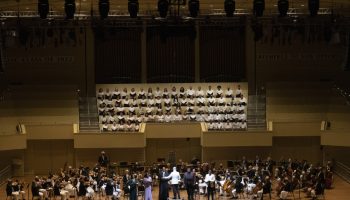“Undercurrents,” curated by Erika Diamond, assistant director of Chautauqua Visual Arts’ galleries, is particularly relevant in relation to recent articles, especially one published in July by BBC in which author Jane McMullen details a bold plan that was developed 30 years ago to spread doubt and persuade the public that climate change was not a crisis. Some of America’s biggest industrialists, and a public relations genius, began a campaign to convince us that there was scientific uncertainty on climate change. And this had devastating consequences for policy and action that would have begun to address the global issues related to our environment.
Water is the underlying theme of all the artwork in “Undercurrents,” currently on display through Aug. 21 in the Strohl Art Center. Diamond brilliantly ties the theme to Chautauqua Institution’s history with a work by North Carolina-based artist Marek Ranis. Chautauqua’s venerable start as an educational camp for Sunday school teachers used Palestine Park, a scale model of the Holy Land on Chautauqua’s grounds, to explain the geography of the area. Since then, the Institution has operated each summer, offering programs in the arts, education, and, of course, religion. Ranis’ video “Stewardship” is a collection of interviews with Charlotte, North Carolina, spiritual leaders who explain their perceptions of the environment, and our role in it, as mediated through their faith. The perspectives are from Judaism, Christianity, Islam, Hinduism and Buddhism. Rabbi Judith Schindler tells a story of two men arguing over who owns a piece of land; they go to the rabbi who tells them that the land belongs to neither of them, and in fact, the land says that they belong to it.
“Undercurrents” as a whole is arranged to suggest water’s transformation through its many natural states and the implications for climate change. Two stunning digital photo prints on aluminum by Ranis are the entry point to the exhibit. They show icebergs in Greenland, reflected in water and turned sideways. The familiar horizontal landscape is poetically rotated to portrait format, reminding us of our own role in preserving this landscape. The series is titled “Kunstwissenschaft,” which is loosely translated as “aesthetics.” Ranis is interested in how we idealize the landscape. The icebergs reflected in the water below them are breathtakingly beautiful, but also present the uncomfortable reality of melting ice caps and disappearing arctic environments.
One of my favorite works in the show is Merritt Johnson’s “Fancy Shawl for the Frontiers.” She has fashioned a common blue tarp into a woman’s Indigenous dance shawl. Blue ribbon and fringe adorn the life-sized garment. The common, cheap tarp is the kind used to repair or create shelters to keep us dry and protected from weather. Tarps bring to mind emergency fixes after natural disasters or temporary structures in refugee camps. This work suggests celebrating and protecting Indigenous women as guardians of land, water, culture and future generations. The piece encourages us to consider whose land this is, and it is also a reminder that all of us living on this continent are responsible for its well-being.
Indigenous voices are included in other parts of the exhibition, and Diamond aims to develop relationships with these local artists. The Catt Rez Beaders, led by Mary and Samantha Jacobs, are a group of bead workers interested in exploring, researching and creating contemporary and traditional beadwork. Ages of the group span from teenagers to elders, and most live on the Cattaraugus Reservation in Irving, New York. The collective has created two pieces for the exhibition, one being a display of beaded water droplets in a museum vitrine, referencing the preciousness of both our water and first-nations cultural traditions. The water droplets also double as tears; in their statement, the artists tell us that Mother Earth is shedding her tears. In a further effort to connect to the work of local artists, a QR code on the pedestal takes us to the Seneca-Iroquois National Museum, one of the Indigenous tribes of this area.
The Catt Rez artists are also responsible for a beaded painting, “Water is Life,” which punctuates the exhibition with a final statement.
There is a series of lush paintings by artist Asia Freeman, based in Homer, Alaska, who co-founded and serves as executive director of the Bunnell Street Arts Center. These are somewhat traditional landscape paintings of the changing seasons in Alaska. The paintings contain energetic and aggressive brushstrokes, in predominantly icy blue hues. The active marks on the canvas bring to mind Impressionist paintings, but rather than trying to capture the rapid pace of modernity, Freeman’s quick brushstrokes suggest she is trying to capture the landscape before it is gone. Painting is a political act of capturing this drastically and irreversibly changing landscape.
Tali Weinberg’s climate “data scapes” are abstractions of statistics collected from studies of temperature data for each of the 18 major river basins in the continental United States and of the Earth’s oceans. The wall-hung pieces are constructed of medical tubing or petrochemical-derived fishing line, woven with varying colors of naturally-dyed organic cotton string. There is a material relationship between the man-made and the natural materials in Weinberg’s pieces that is poetic. This work draws on the history of weaving as a language for women and marginalized groups. She attempts to create a feminist material archive of the worsening climate crisis.
Jean Shin also relies on relationships between disparate materials. In her work, “Prized to Extinction,” a hand-blown glass jar is filled with vintage mother of pearl buttons. On the pedestal beside the jar are freshwater mussel shells from the Delaware River. Approximately 70% of the mussels in this river are endangered or threatened. As filter feeders, mussels increase water clarity and stabilize bed erosion. Shin is known for her large-scale installations, yet this smaller piece speaks boldly to our material consumption.
Emily Williams also explores threatened sea life in her stunning flameworked borosilicate glass sculptures. In her glass reef project, she studies marine life that is unique to coral reefs, and then crafts them from glass. Most of the marine life that inspires these sculptures is threatened, and her artist statement relays the sobering reality that 70% to 90% of the world’s coral reefs are projected to disappear in the next 20 years. The fragility and ghost-like translucency of the glass Williams creates mirrors the precariousness of disappearing coral reefs.
Derrick Woods-Morrow presents three photo prints that explore the complicated histories of Black sexual freedoms. He aims to represent alternative queer futures. His black-and-white photos are of African American figures on a beach. In one, titled “Frederic on Lake Pontchartrain | After Lincoln Beach,” a man posed as an ingénue in a vintage women’s beach costume and swim cap wades out into the water. Lincoln Beach was an amusement park in New Orleans, which from 1939 to 1965, during the Jim Crow era of racial segregation, was designated for the area’s African American population. The photograph in itself is poignant, tying racial segregation and queer freedoms. Woods-Morrow represents voices of those systematically oppressed, questioning who has, and has had, access to our natural resources.
The works in “Undercurrents” call us to action to admire and protect the water. The artists speak of environmental responsibility and reference the socio-political issues underlying our relationship to water. The artists use a wide range of materials and approach the topic from varying tactics, but all remind us of the preciousness of water and all the natural resources that surround us.
Pittsburgh-based Melissa Kuntz is a professor in the Department of Art at Pennsylvania Western University, Clarion Campus. She holds an MFA and an MA from SUNY Purchase and a PhD in Administration and Leadership through the department of Sociology at Indiana University of Pennsylvania. She has been writing art and book reviews since 2002, for publications such as the Pittsburgh City Paper, Canadian Art Magazine, The Chautauquan Daily, and Art in America Magazine. Her upcoming research publications use quantitative data analysis to study the impact of race, gender, socioeconomic status, and prestige of art schools on gallery representation and museum collections and exhibitions in the United States.





